Are you looking for a profitable niche for your next online course? One of the great things about teaching online today – online education is in demand, now more than ever.
Virtual learning was already rising in popularity before 2020, and the trend is still going strong.
If you want to earn money by creating an online course, it helps to understand the best niches for online courses.
That’s why you need to start with research to determine the profitability and popularity of your niche ideas. In this post, we’re going to give you several ways to research the best niche for your next online course.
What Online Courses are in Demand?
You might be surprised to learn that there are a lot of profitable niches outside of the usual training topics we all know.
Going after niches like weight loss, personal finance, health and beauty, self-help, life coaching, pet training, and “make money courses” is a good business move.
But before you can pick the best niches by looking for the smallest niche market, you need to realize that low competition is not always a good thing.
Sure, you could create something that your target audience wants and that has never been done before. But you’re more likely to succeed if you go after proven profitable niches.
Your profitable online business starts with your ideas for teaching people what you know, combined with solid internet market research.
Let’s get started, so you can validate your ideas with real data and start getting customers lined up to learn!
How People Find Online Courses [Data]


How do you make money with an online course? You have to sell it to people. Here is data from SimilarWeb showing how people interested in pursuing online education discover courses on the top education networks.
- Udemy: 102.91M estimated monthly visitors – 20.08% from search, 6.95% from social, 3.14% from referrals, 2.58% from mail, and 3.29% from display
- Coursera: 47.64M estimated monthly visitors – 23.72% from search, 5.18% from social, 5.10% from referrals, 4.08% from mail, and 1.97% from display
- Tutorialspoint.com: 31.8M estimated monthly visitors – 87.41% from search, 0.50% from social, 0.60% from referrals, 0.16% from mail, and 0.09% from display
- edX: 18.6M estimated monthly visitors – 23.23% from search, 5.33% from social, 5.27% from referrals, 4.07% from mail, and 2.39% from display
- Guru99: 14.71M estimated monthly visitors – 87.83% from search, 0.25% from social, 0.35% from referrals, 0.22% from mail, and 0.03% from display
- Masterclass: 10.22M estimated monthly visitors – 60.8% from search, 4.29% from social, 0.64% from referrals, 1.33% from mail, and 3.05% from display
- Skillshare: 8.38M estimated monthly visitors – 26.65% from search, 16.33% from social, 1.42% from referrals, 3.58% from mail, and 1.57% from display
- Pluralsight: 7.7M estimated monthly visitors – 48.16% from search, 3.89% from social, 4.69% from referrals, 3.00% from mail, and 0.72% from display
- Creativebloq: 7.1M estimated monthly visitors – 83.2% from search, 2.99% from social, 1.06% from referrals, 0.28% from mail, and 0.05% from display
- Futurelearn: 6.9M estimated monthly visitors – 39.78% from search, 5.19% from social, 5.7% from referrals, 3.83% from mail, and 1.59% from display
- Simplilearn: 3.63M estimated monthly visitors – 65.57% from search, 4.47% from social, 1.13% from referrals, 1.35% from mail, and 1.14% from display
- Classcentral: 1.74M estimated monthly visitors – 65.36% from search, 5.74% from social, 4.14% from referrals, 1.76% from mail, and 0.06% from display
What can we learn from these twelve platforms that offer online classes from celebrities, experts, professionals, and universities? Search is the leading, identifiable traffic source for all of the above sites.
Search traffic is followed by traffic from social media, referrals, mail, and display ads. We will discuss each of these in detail in the upcoming sections on how to find a profitable niche based on these identifiable traffic sources.
What is missing from most website analytics? The unidentifiable data.
Direct traffic typically reigns as the top traffic source for most websites, except for the ones that are receiving over 40% of their traffic from search engines.
When you find direct traffic in your traffic sources or channels, it encompasses website visitors that come from an unknown source. For example, any of the following may appear in your website analytics.
- People who arrive at a website by typing the address in their browser’s URL bar.
- People who arrive at a website by clicking on a browser bookmark.
- People who use a browser, extension/add-on, or setting that protects their privacy from any analytics or ad tracking.
- People who use a browser in a mobile app that does not pass information to analytics tools, taps on a link from an app that opens up a link in their mobile browser, or copies the link from an app and pastes it in their browser.
- People who click on links that are tagged with rel=noreferrer, telling analytics tools not to pass the referring site information.
The thing to remember is not to worry about unknown traffic sources. If you build an online course that people can find in search engine results and social media networks, you will get a steady stream of direct traffic as well.
Why You Need to Research Your Market & Niche First
Why does the right niche market matter when it comes to online courses?
It is simple – if there is no demand for your course topic, you cannot expect to make money. Your target audience needs to be looking for the type of training you want to create.
Conversely, a topic that is in high demand isn’t necessarily profitable if the market is too saturated.
It is crucial that you know what the profit potential of your niche is before you start creating your course. A profitable online course takes a considerable investment of time and resources.
If you want yours to generate a positive ROI, invest your time and resources into the right niche.
It’s not always crucial to research all of the platforms that offer online classes, however.
Unless you are researching the most popular course topic for a university-free online course selection, there is no need to research free online courses from universities.
What are some examples of niches?
If you’re truly starting your business from scratch and trying to come up with ideas, it helps to have an example of niche courses selling well.
If you have expertise enough to teach on these topics and open your own online course store, here’s some inspiration:
- Digital skills: from coding to web design, video editing, and tech
- Style challenges: how to organize your personal into capsule wardrobes
- Health and fitness courses: from weight loss to nutrition, movement classes, and everything in between
- Writing and creativity: digital MFAs and freelance writing
- Business & internet marketing: affiliate marketing, and other business management skills
- Beauty skills: professional makeup training and online beauty schools
How to Find the Best Niche for Search Traffic
Are you ready to determine the most profitable niches based on search traffic potential?
We are going to use the 7-day free trial of Semrush to do the first leg of research for a profitable niche. Here is what it can tell us.
- How many estimated searches are there for keywords related to online courses?
- What online class platforms receive the most traffic from search engines?
- What online courses and categories receive the most traffic from search?
- What online courses are most profitable based on how much advertising spend is placed on relevant niche keywords. (Hint: most advertisers would avoid spending ad revenue long term on an unprofitable course or category of courses.)
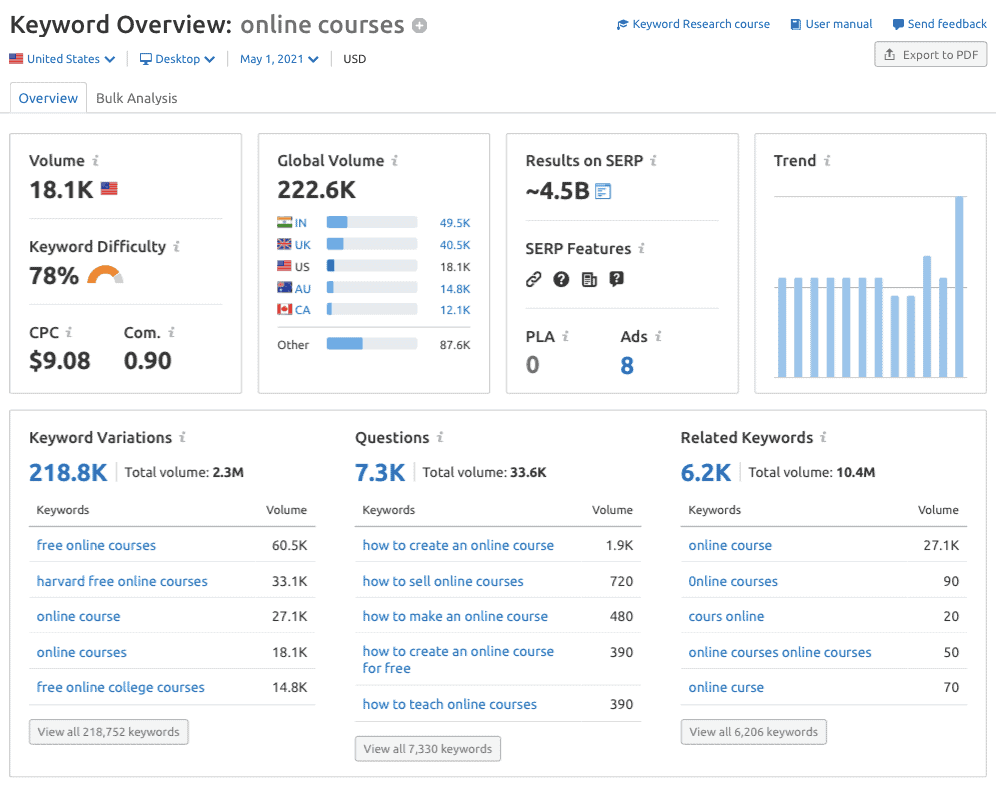

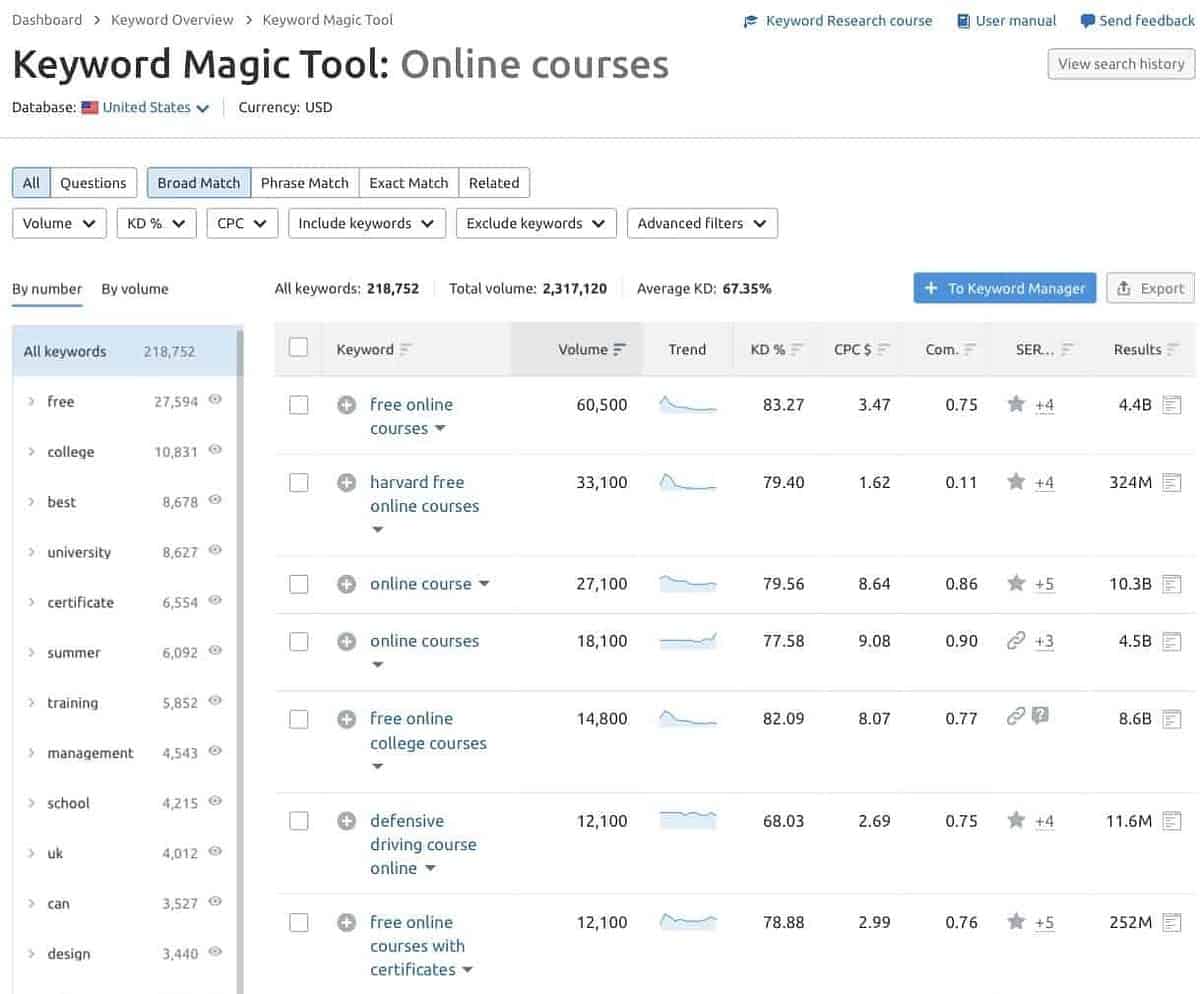





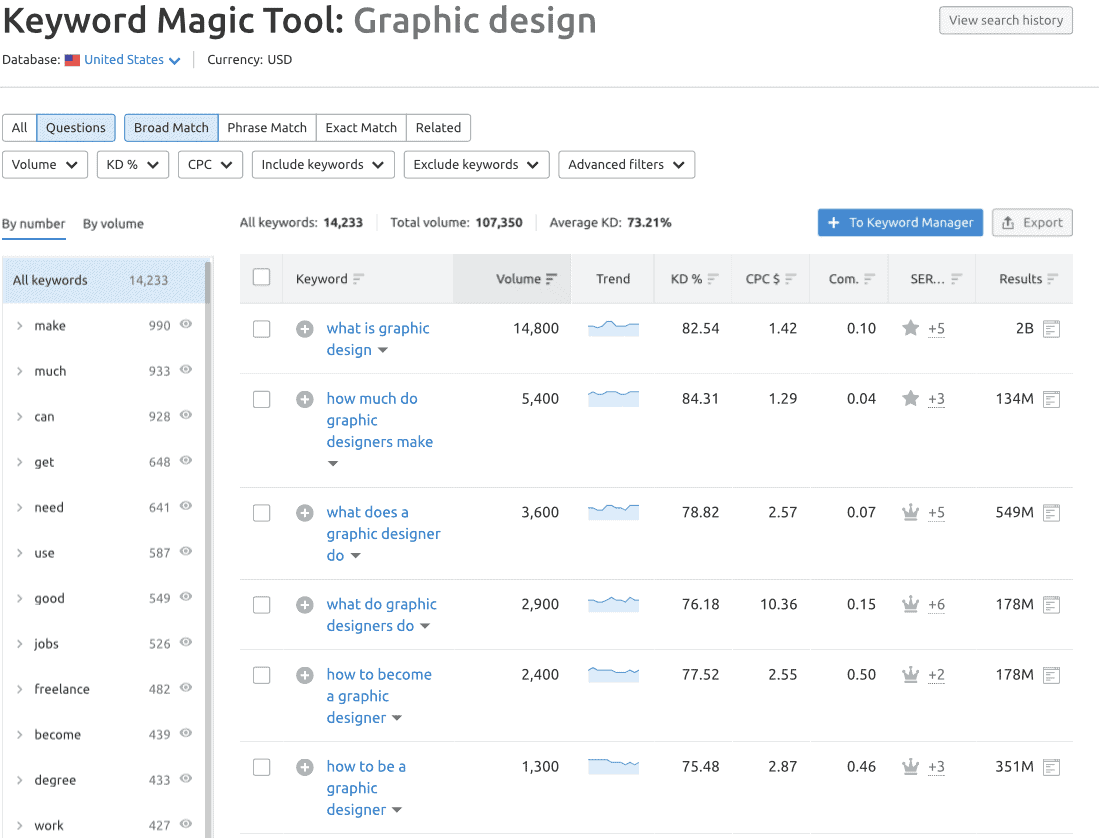

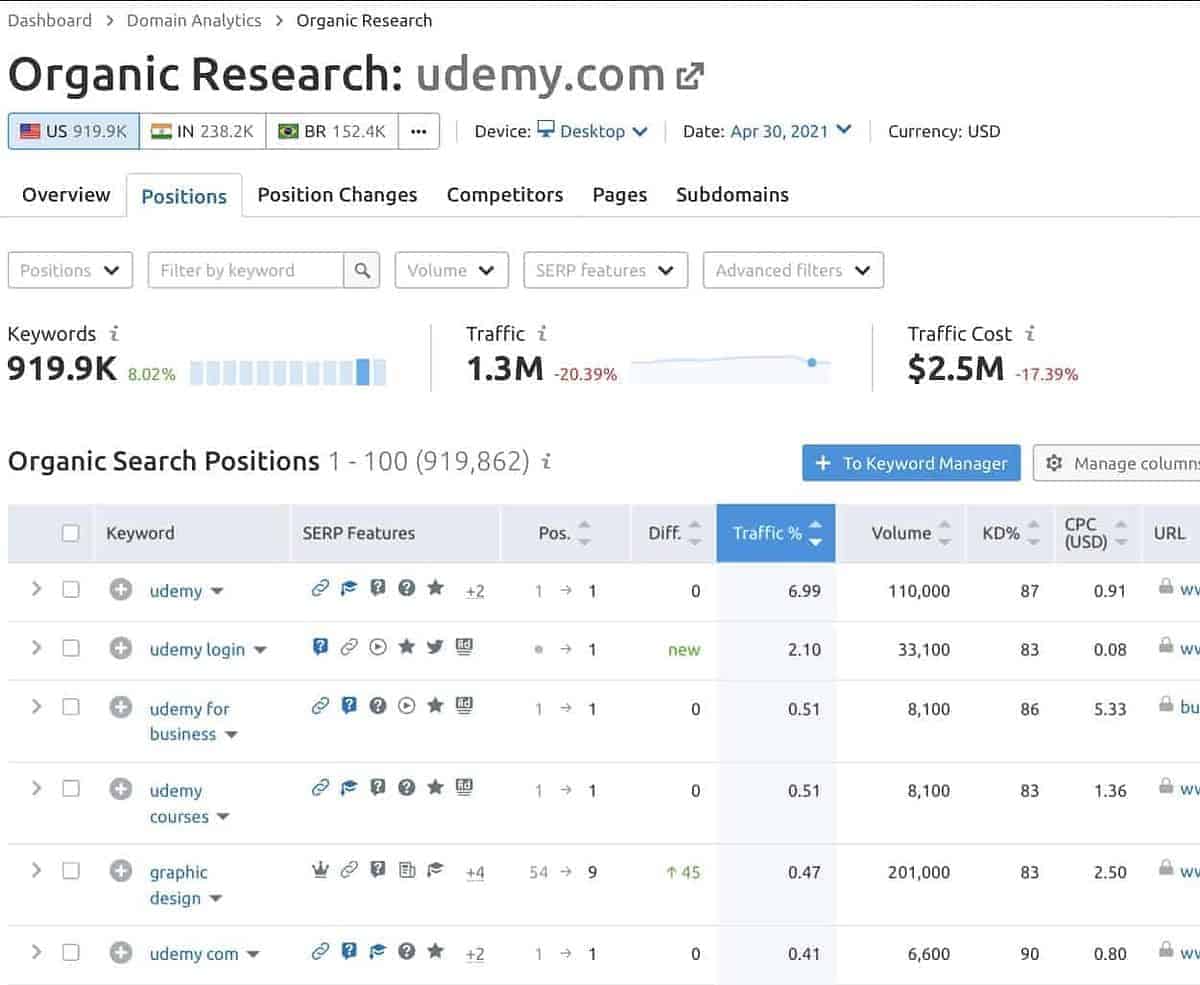

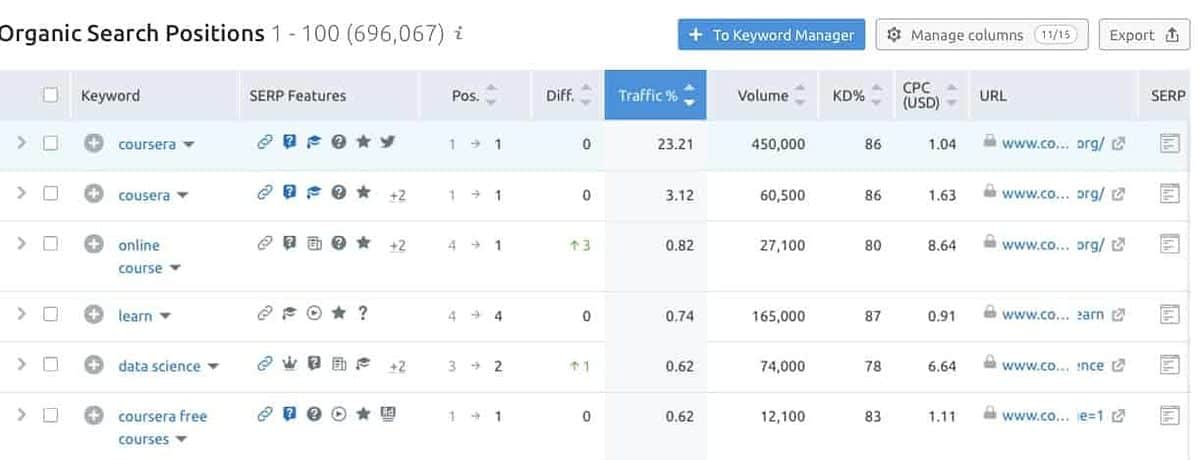



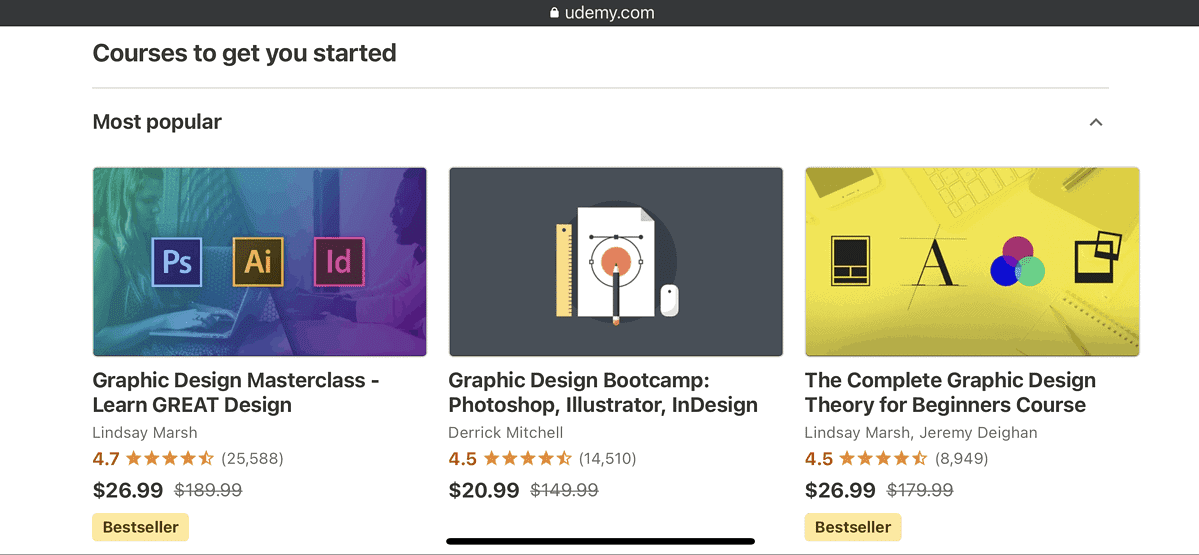

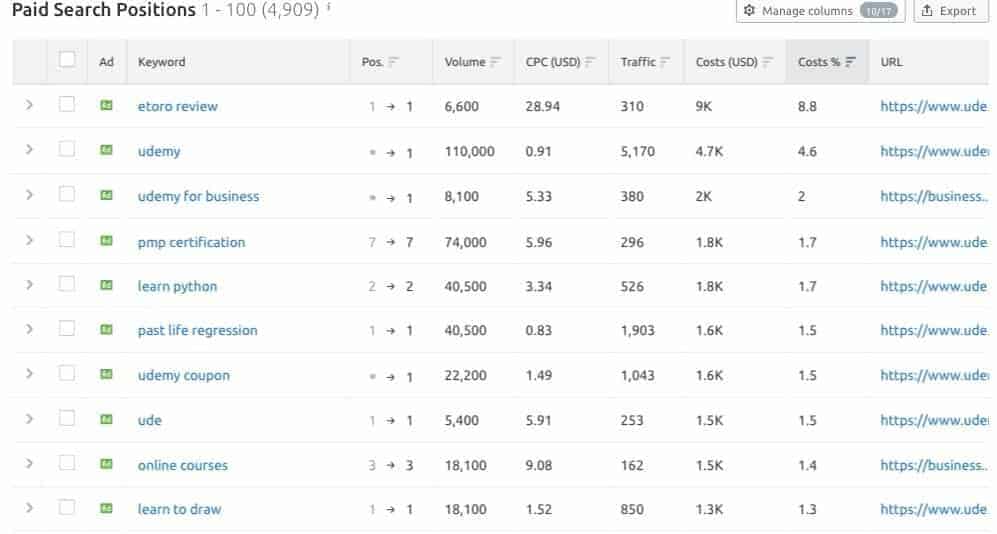

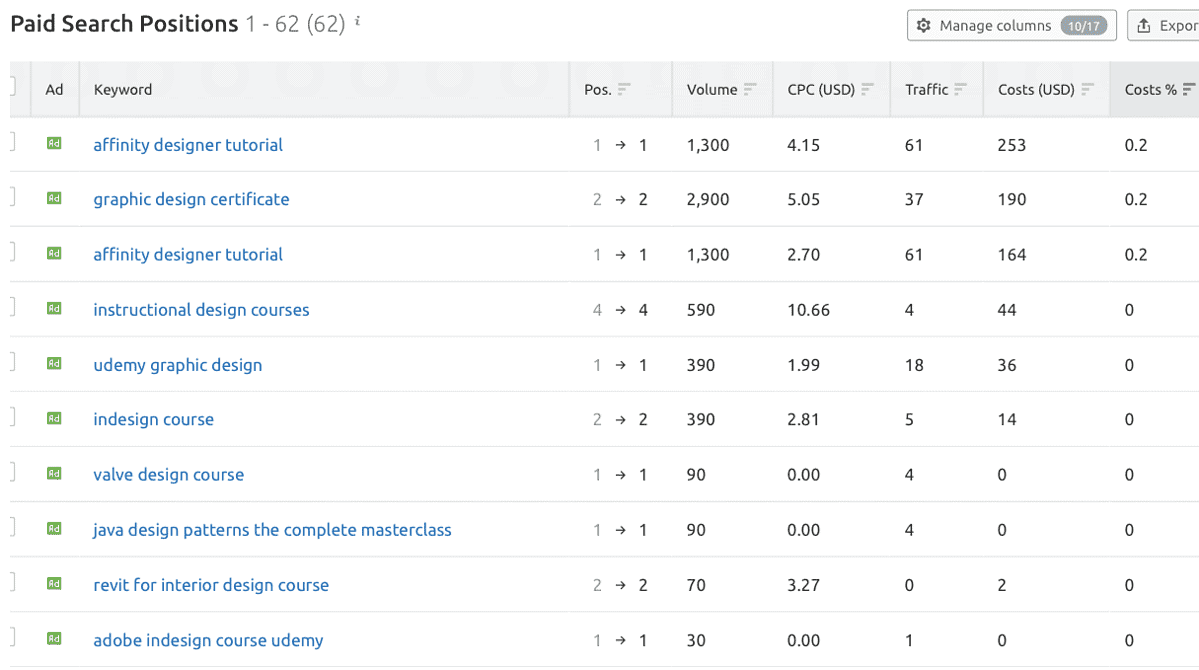

Let’s start with the estimated searches for keywords related to online courses. First, you can see how many searches the term receives.
Then, you can click through to keyword variations, questions, and related keywords. Keyword variations show the following as the top searches for online courses.
If you are a graphic designer who wants to create an online course, you may naturally want to focus on design-related topics. You can click on the keyword groupings to the left of the results to see keyword variations related to that group.
In this case, the broad keyword to start with would be “design”. This would allow a graphic designer to see the more specific topics and niches that fall under their skill set.
If you are in a different niche, think of the best broad term to use for your own research: Microsoft Excel, quilting, gardening, photography, astronomy, basic piano, etc.
There are plenty of ways to incorporate popular keywords into the framework of your course.
Online graphic design courses are popular, with an estimated 5,400 searches per month. You can also see that the trend for monthly searches stays consistent throughout the year.
You want to choose topics that receive a steady or growing amount of interest, as noted in the trend graph representing the last twelve months of estimated monthly searches.
You can also search for broad keywords for your niche or business. This will reveal the most popular keyword variations and questions asked in search engines.
From this list of questions, you may find the main topic, subheader, or primary subtopics.
How to become a graphic designer, how much do graphic designers make, and what is graphic design are examples of keywords you could place in your course to ensure there is interest from search users.
Use the trend column to confirm that the keywords or questions are staying steady or increasing in popularity over a twelve-month period.
It takes a lot of effort to create an online course, so don’t want to start making money online and see the interest dry up suddenly.
Online graphic design is a popular topic on the top online learning platforms.
Some of the top keywords driving traffic to Udemy.com from organic (unpaid) search results, as shown below, are graphic design, graphic design courses, and online graphic design courses.
It’s easy to see the difference between online learning platforms when you look at the top organic keywords driving traffic from search within specific countries. (These reports are all based on Google.com/US search data.)
You can use the search box to do a more targeted review of keywords related to your niche to see how much search traffic they generate for Udemy and other platforms.
From there, you should visit the landing pages for keywords related to your niche. They should help you find more specific topics within your niche that are popular with the platform’s students.
You can even use this to inform your own marketing and choose a price for selling your online courses.
Best of all, you can see the keywords that online learning platforms pay for on Google Ads. These are likely the keywords that generate the most profit for their company, based on the percent of their ad spend.
A search for design reveals if a platform invests in design courses and how much is invested in those courses.
You can use this information to confirm the demand in your niche for an online course or use it to determine where to publish your course on a particular education network.
Your best bet if you want full control of your course and a larger percentage of your revenue, is to publish your course on your own website. That way, all of the income you generate in your online business is yours to keep or re-invest.
You can be inspired by course networks without joining them. In particular, click through to view the ads and landing pages used by your future competition to craft your own ad copy and landing page designs.
You may need to include Google Ads (paid search) as a traffic source for your course in the future. Especially if you are trying to build an audience, launch a course, establish word of mouth referrals, and collect testimonials.
You can use the data from Semrush to find out how much advertising your course to the right audience would cost, based on what you find other platforms spending.
Use this data to set a strong price for your course. The goal would be to achieve a positive ROI when running ads. If your CPA (cost per acquisition) is higher than your course price, you need to adjust accordingly.
How to Find the Most Profitable Niches for Social Media Traffic
















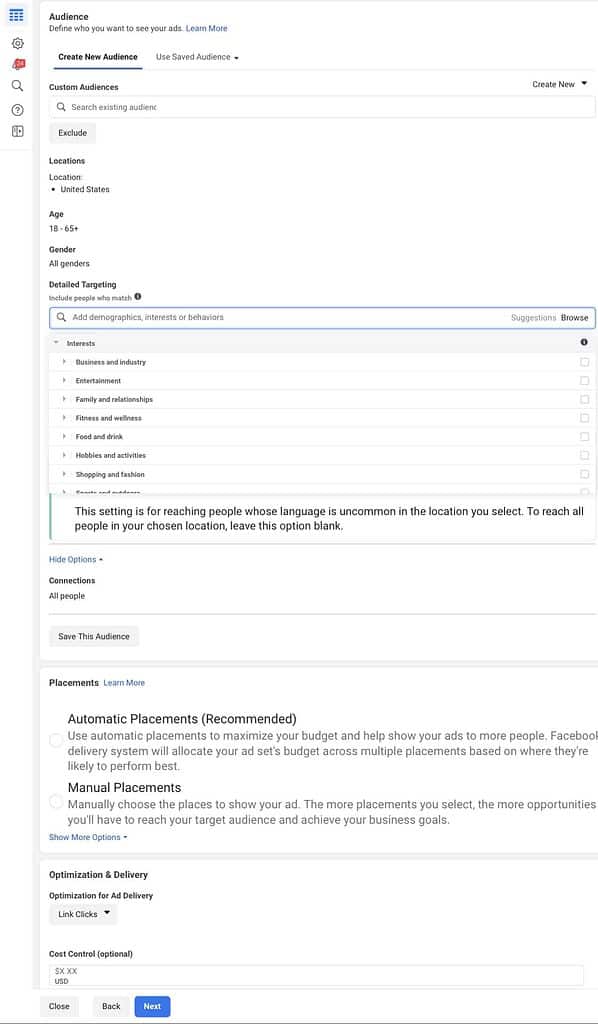

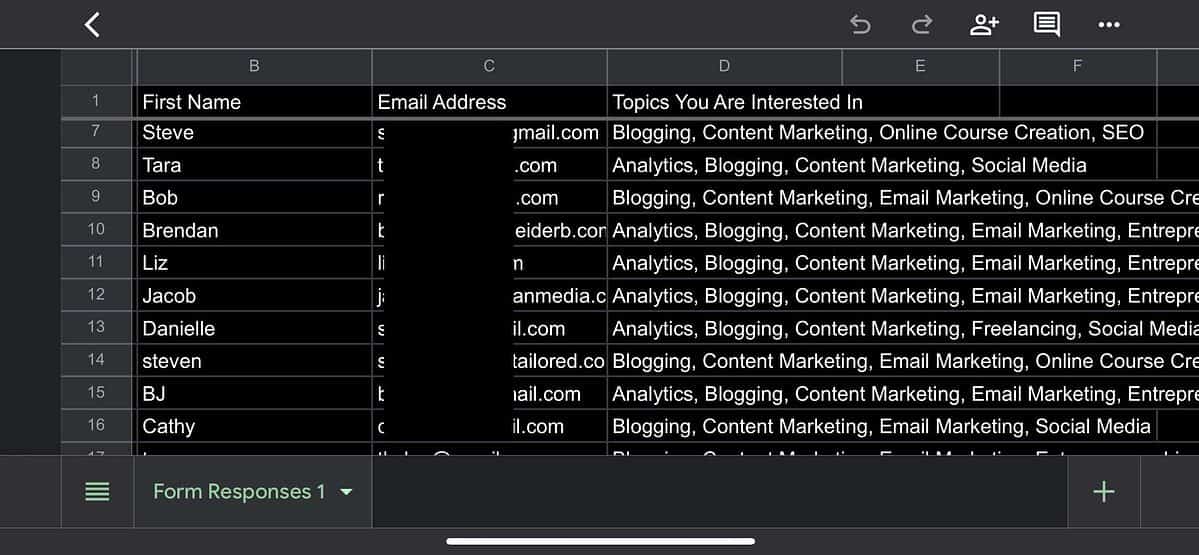



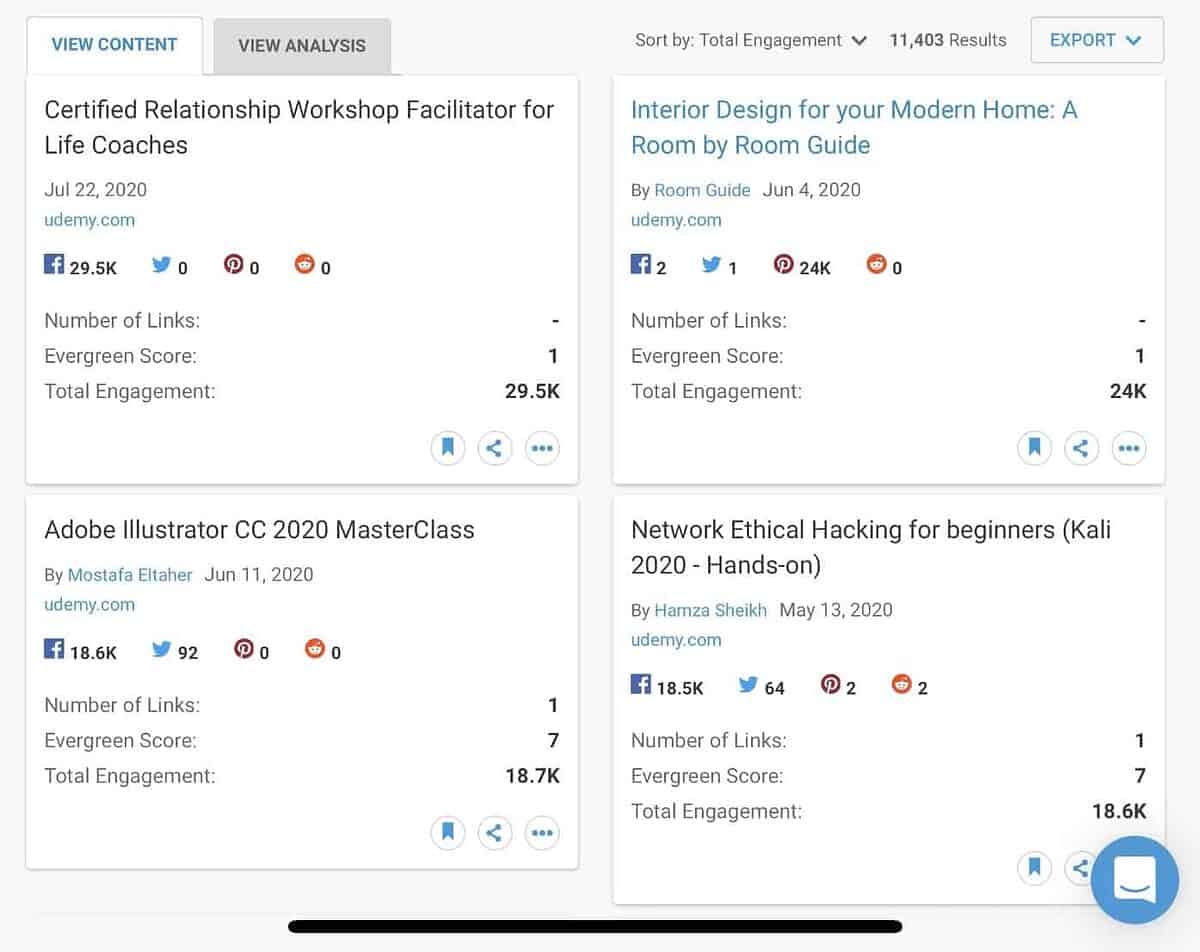

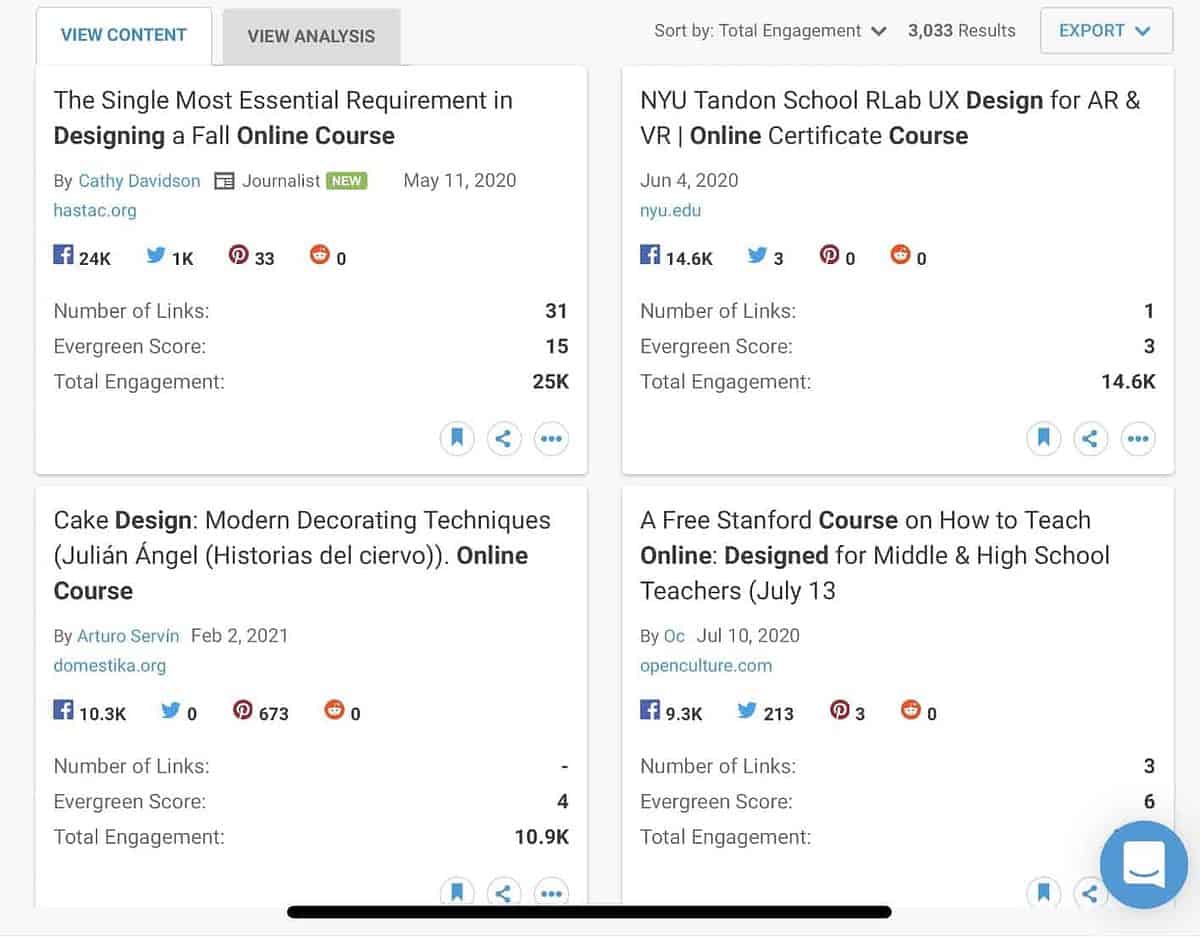



Social media comes in as the second top source of identifiable traffic for online course platforms. There are a few ways to use social media to discover the best niche for your online course.
The easiest is if you already have a social media following. You can use the built-in survey tools on the top social networks to find out what your audience wants to learn from you.
On Twitter, you can tweet out a poll to your followers. Add relevant hashtags to reach a broader audience that may also be interested in online courses in your niche.
On Instagram, you can ask a question or make a poll on your stories for followers to respond to within 24 hours. This is used by online business and e-commerce stores all the time, why not use it for digital course marketing too?
On Facebook, you can create a poll for your Facebook page fans. If you don’t have a lot of followers just yet, you can also poll members of groups you have joined, based on their settings.
On LinkedIn, you can create a poll on your professional profile or company page. If you have too small of a network or few company page followers, you can poll the members of groups you have joined.
Additional ways to find out what courses are in demand? Try networks like Quora, where people come to ask questions and get answered from experts. You can see answers to questions about the best courses in your niche as well as the top questions people have about your niche in general. Any of these answers could provide inspiration for your course.
Reddit also has a question-and-answer post format within their community. You will find people asking for recommendations on courses and questions about your niche.
You can also use the search box on Twitter to find recommendations for popular courses in public tweets. Or you can find people looking for more online courses on a particular topic.
Facebook and LinkedIn also allow you to search for keywords in public posts and within groups. Both could reveal discussion about courses in your niche and questions about your niche as a whole.
You can use these discussions to gauge interest in courses within your niche within any given group or community. Note or bookmark any communities that are particularly active and positive about online courses – they may be more receptive to promoting your course once it’s live.
Each of the above social networks will also allow you to reach targeted audiences with paid advertising. Choose the audience you would like to sell to, and ask them what they want to learn and how much they would pay to learn it.
Most social networks, including Facebook/Instagram, LinkedIn, and Twitter offer detailed targeting options for you to reach your ideal customer.
Facebook Ads Manager has a useful feature that allows you to save the audiences you create for future use. If you get positive responses from particular audiences, you’ll know to target them with ads for your course once it’s live.
To create your survey, you could use a free tool, like Google Forms, or a premium service, like SurveyMonkey.
The former will collect the answers and allow you to analyze them, while the latter will run the analysis for you, providing a more user-friendly summary of the results.
Capture email addresses to let people know the results of the survey, or to invite them to future online courses you develop.
They will make the perfect warm audience to advertise your new course to once it is live.
When you go to design your social media ad, you can use tools like Canva to create the ad image. Remember that teaching people and selling have a lot in common: the more clear you can be in your marketing message, the better.
AdEspresso offers great examples of Facebook Ads from specific industries (like real estate). You can use these as inspiration for your ad image, video, and copy.
Another great tool for profitable course research? Buzzsumo. Use the free 30-day trial to research the online courses that are shared most on the top social media networks.
For example, you can see the most shared courses on specific platforms.
You can also see trending content about online learning and see what online courses are generating buzz throughout social networks.
You can also find digital influencers – active social users with engaged audiences – who have shared content about online learning and a particular niche. This can help you connect with fellow course creators that are promoting their courses and the students who are recommending courses they have taken.
You may want to review social profiles and the latest posts of each influencer before connecting to discuss courses in your niche.
Use the opportunity to learn more about how other course makers build their audiences and market their products.
While you talk to people about courses in your industry, write down any particular questions or pain points that come up more than once.
They may be things you need to address in your course by narrowing or broadening your niche topic.
For example, you could create multiple offerings to cater to different groups of people: personal, small business, management, or enterprise. The core training may be the same, but selling to different customers could create more opportunities for growth.
How to Find the Best Niches for Referral Traffic
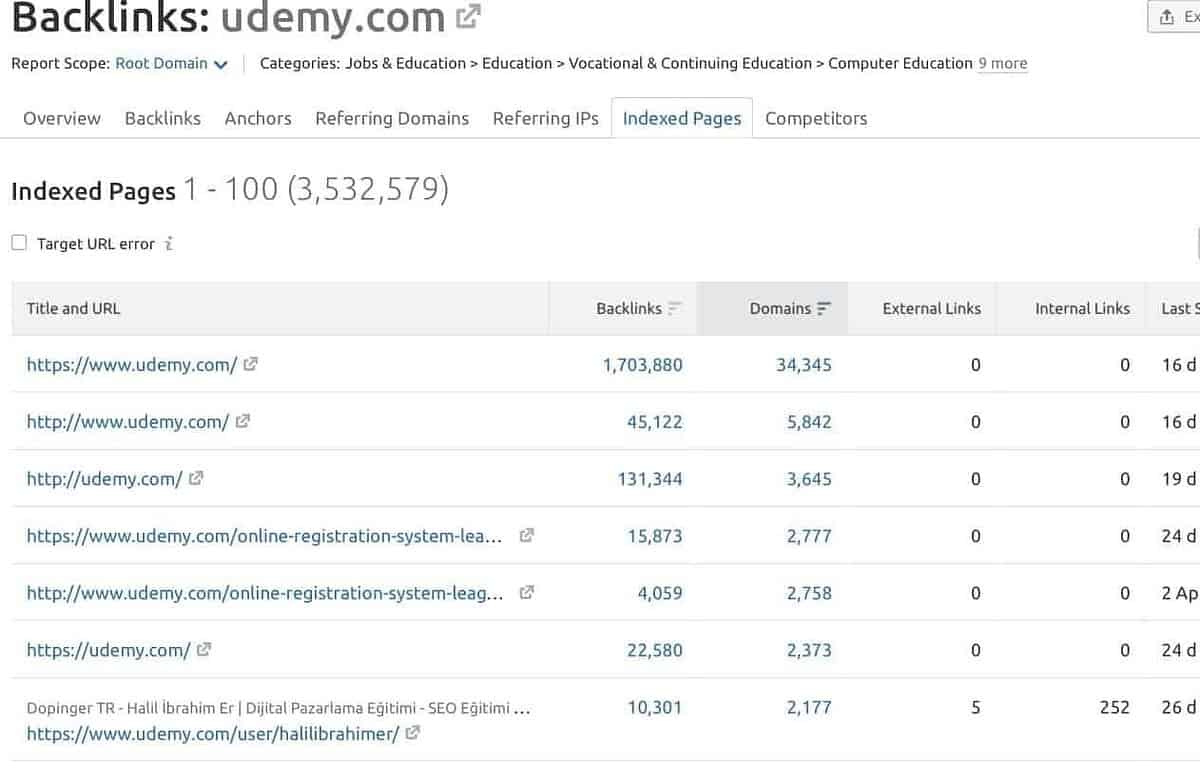

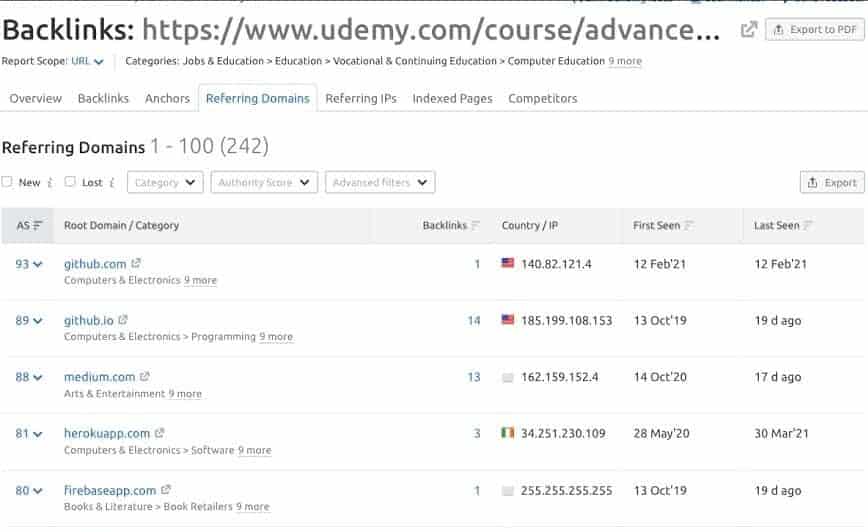

Head back to Semrush – or another SEO backlink research tool – to find the best niche for referral traffic.
The goal of this is to find the pages on online learning platforms that have the most links from other websites.
The pages – courses, course categories, and users/instructors – with the most links are the ones most likely to generate referral traffic. Focus on the ones with the most links from unique domains, not just the highest backlinks count.
Remember that companies with strong rankings in search tend to have a solid link-building strategy.
The pages with the most links could be from people genuinely linking to a course or category of courses they recommend or they could be from a link request sent by the company.
When you find a page relevant to your niche, export the backlinks. Those backlinks may contain articles like “Best Graphic Design Courses” – the perfect article to request a link in once your course is live.
Once you’ve launched your course, you can add services like Monitor Backlinks to your toolbox. It will help you easily monitor your course’s links and notify you when your competitors get links for their courses.
Those could be links that you could gain for your course too, especially if it’s a compilation of the best courses in your niche.
How to Find a Target Audience for Email Traffic


Most successful business owners will tell you that the “money is in the list.” Although email may not be the largest source of traffic to your website, it will likely be the best source for converting traffic.
Email is the channel businesses around the world use to close the digital sale, especially when it comes to online courses.
If you have an email list, you can use the survey idea from the social media section earlier to find out what they want to learn about and how much they would be willing to pay for a course on it. (Don’t want to scroll up? Use Google Forms (free) or SurveyMonkey (premium).
For those without an established email list, there are email lists you can buy for B2B or B2C. While most would not suggest it, there are ways to make it work.
First, buy a highly targeted list. You don’t want a general list of thousands. You want a focused list of people or businesses that match certain criteria.
Look for email list services that can connect you to an audience of your ideal customer, like Exact Data. They have a targeting system similar to Facebook Ad Manager for individual ad and saved ad audiences.
Next, use a different email marketing service. Clickback, Hotsol, and Prospect.io are examples of email marketing services that allow purchased lists. You can officially opt them into your main email list later.
Now, take the earlier mentioned survey idea.
- What are you struggling with today in terms of design?
- Would you be interested in a video/text course on it?
- How much would you pay for that as an online course?
- Would you like to add your email to a list about future courses on design from me, an experienced designer and teacher since 1997.
Send the survey and use SurveyMonkey to make a professional first impression that most survey takers are familiar with.
Send opt-in invitations to everyone who confirms they would like to be added to your email list on a full service marketing automation solution like Mailchimp, GetResponse, or HubSpot.
If you’re buying a large list and anticipate a high volume of opt-ins, consider sending an opt-in invite to everyone who provides their email automatically using services like Zapier.
They connect tools like SurveyMonkey to popular email marketing/automation platforms, allowing them to automatically pass survey respondents’ emails from the survey response to the email service of your choice.
Zapier is also a great service to free your time up from admin tasks and make time for the creative work that will make your course successful.
Be sure that your main marketing automation or email software list has a welcome email and series prepared for new subscribers.
This series should get them ready for your upcoming course promotion by keeping them engaged. You can also use it to get insights into what students want from your course, offer a scholarship, and much more.
How to Find the Best Niches for Online Courses with Display
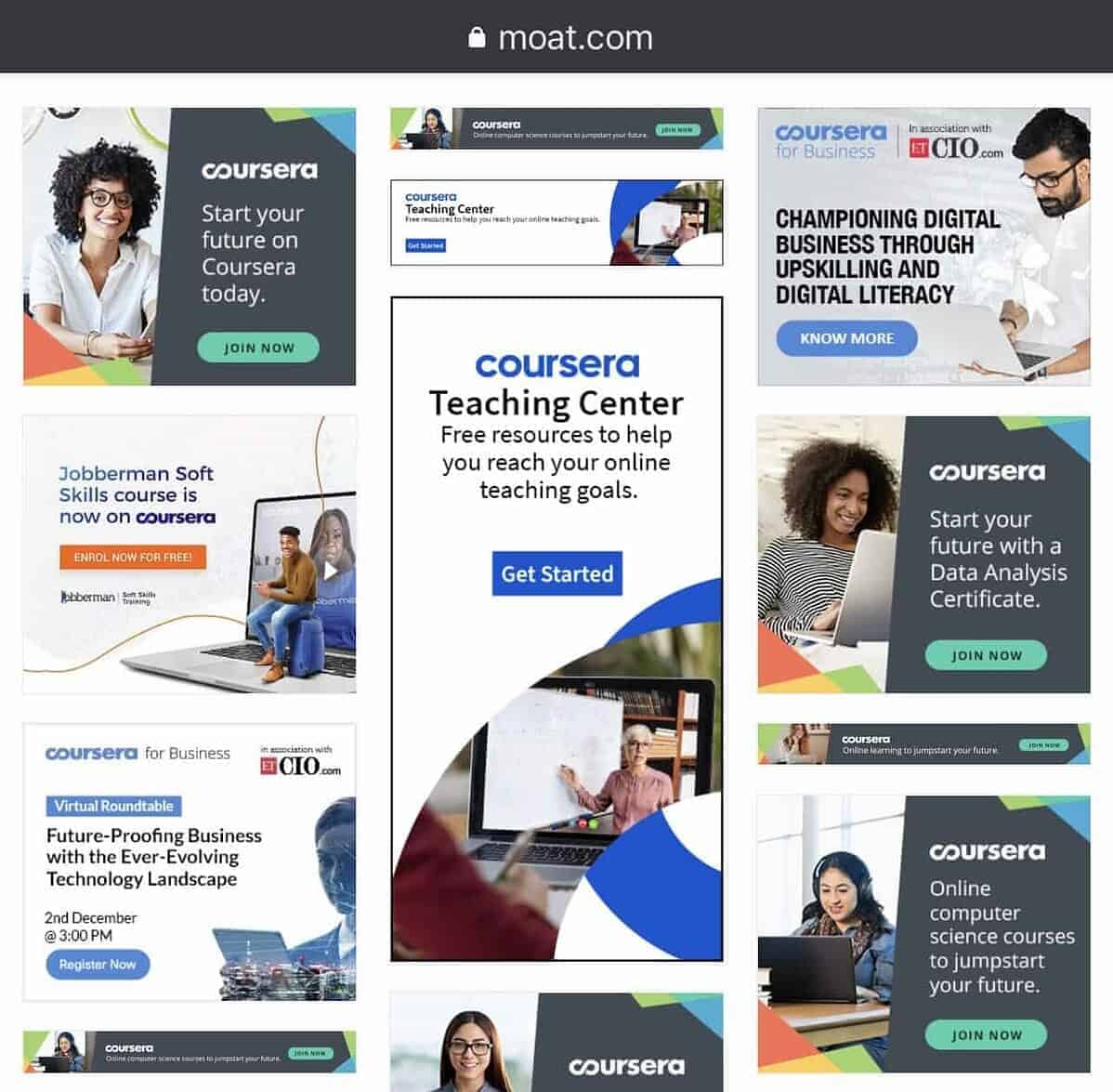

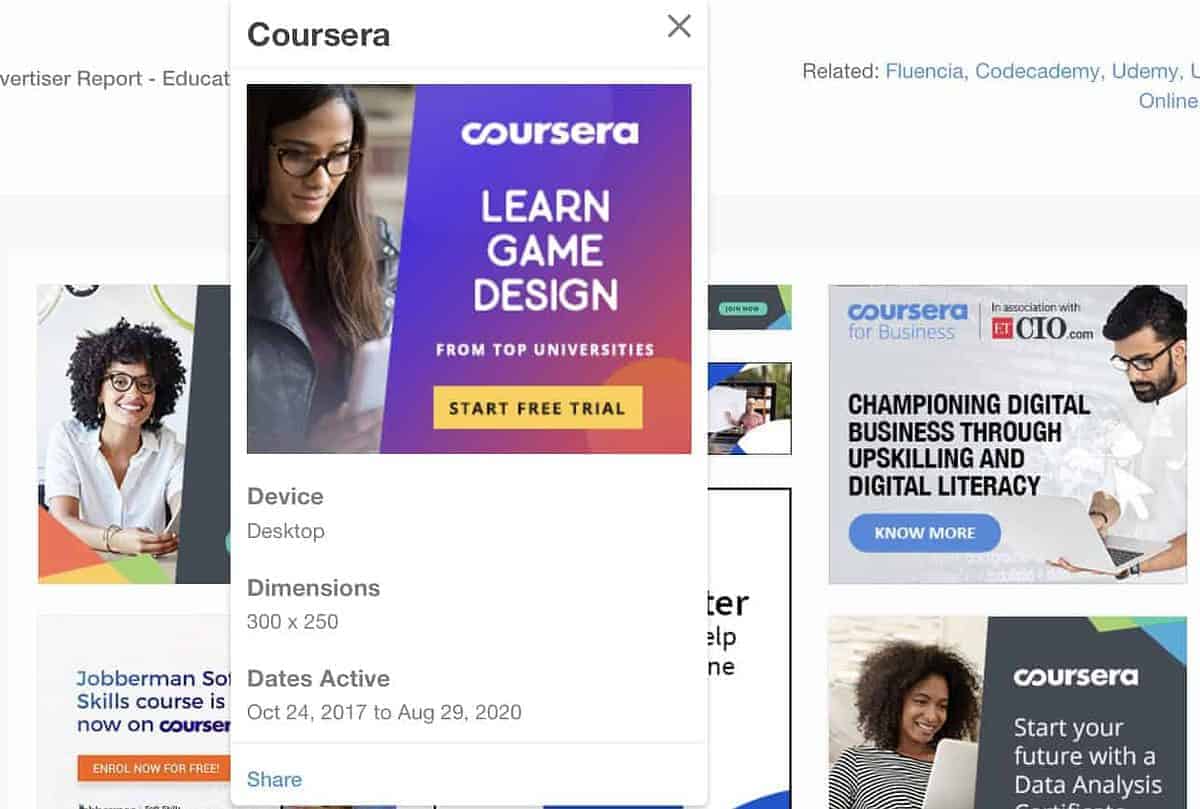

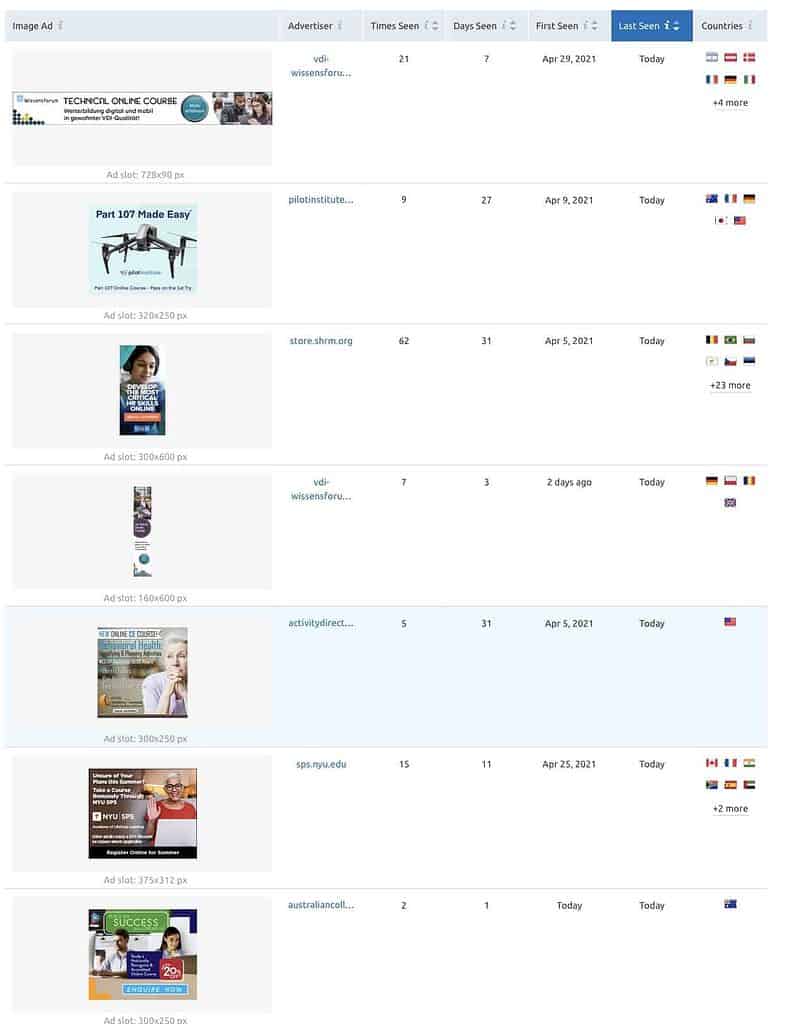



Another channel to promote your course once it is launched is display advertising. Google and other platforms allow advertisers to place image and video ads on popular websites throughout the web.
You can preview the companies running display ads for their courses on services like Moat for free. It’s a good way to see what course providers are paying to advertise, based on potential revenue generation.
You can get a quick feel for the difference between platforms and the course topics that are popular on each.
Click on ads related to your niche to see how long the ad has been in rotation. The longer the duration of ad time, the more likely it is generating positive ROI.
Save your favorite examples as reminders of what is working best for attracting students to particular online courses.
You can also find display ads in competitive research tools like Semrush. As shown below, you can search for ads from multiple advertisers on a specific keyword phrase, like online courses.
Click on an ad to see more details about it.
Putting It All Together
We hope you take good notes while researching a profitable online course topic in your niche based on search, social, email, and display popularity.
Once you have completed research for the top three niche topics you are interested in, you should have a strong feel for which niche topic is most in-demand and likely to convert.
What really matters is your passion for your niche. Creating a successful course means you will be immersing yourself in this topic. And once you launch your course, you will continue immersing yourself in the niche by supporting your students and promoting your course to new audiences.
Next Steps
Although we didn’t end the debate on which niches would win in a battle to earn the most money online. Would it be weight loss, pet owners training, personal or life coaching, health management, personal finance, or income creation?
We did show you new skills to help you get started and narrow down your course idea.
Once you have chosen your niche, you need to take the following steps to bring your profitable course content online.
Be sure to visit our checklist that covers what you need to know about creating an online course.
The world is hungry for your brand of teaching, and you have a lot of value to offer in your training program.
You may also want to take a deep dive into affiliate marketing because many successful small business owners earn more money by having affiliates promote their courses.




